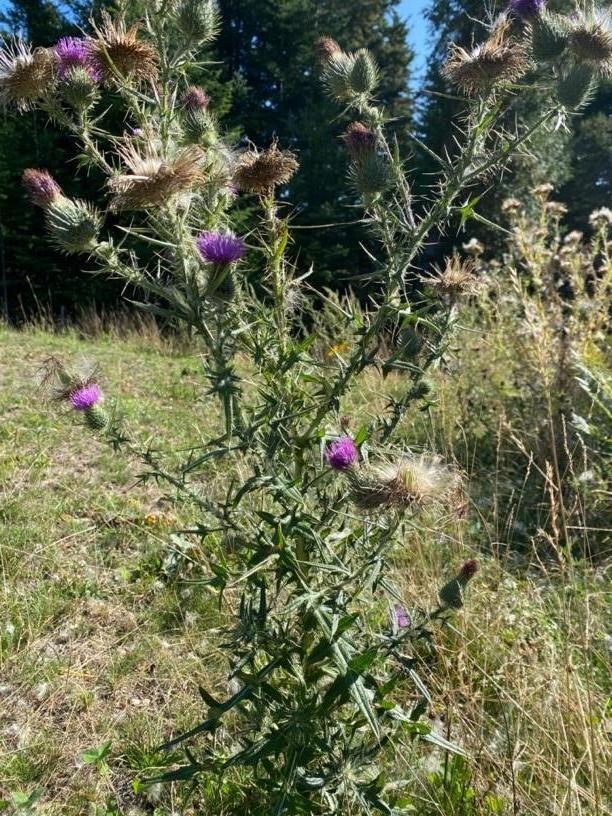Last updated: January 25, 2024
Article
Invasive Plant Profile: Canada and Bull Thistles

NPS Photo
By Sophia Cameron, Invasive Plant Management Intern and Jesse Wheeler, Vegetation Program Manager
Most can recognize a thistle without much previous knowledge. These invasive plants have distinctive wavy leaves with prickles or thorns growing from the edges. Often, hikers and other outdoor recreationists feel these vicious spikes before they see the plant. Canada thistle (Cirsium arvense) and bull thistle (Cirsium vulgare) can be difficult to differentiate to the untrained eye, as they both have those notorious spiked leaves. If the thistle has rhizomes—roots that extend out from one plant to grow another plant nearby—then it is likely a Canada thistle. If it does not have rhizomes, but has a taproot and has spiny wings up the length of its stem, then it is a bull thistle. Bull thistles have also been described to be larger and “meaner-looking” than the Canada thistle.
Both species mature to be about four feet tall and can grow in just about any environment. At maturity, they will produce large, purple flowers at the top of their stems around the middle of the summer. In late summer or early fall, these flowers will become seed heads with dandelion-like seeds. These seeds are dispersed primarily by the wind but may also attach to animals passing by. While bull thistle lives for just two years (biennial), usually flowering the second year, Canada thistles are perennial weeds, surviving more than two years without external interference. This means that the same mature plant can produce millions of seeds in their lifetime.

NPS Photo/Sophia Cameron
Where does it grow?
Canada thistle is often found in agricultural areas and along roadways where there are high levels of disturbance. In these areas, native thistles can be mistaken for invasive thistles and removed, which opens up a niche for the invasive thistles to inhabit. Canada thistle thrives in colder, seasonal climates, so it is less abundant in the southeast.
Why is it invasive?
Both species have been found in all 50 states and Canada. Their success can be attributed to diverse methods of dispersal, including both wind and animal transportation. The seeds can travel miles on the wind due to their lightweight nature and sail-like heads. They are also a food source for small birds and can be ingested by herbivorous mammals while they are feeding on the leaves. Canada thistle was also found to be allelopathic, which means that it secretes chemicals from its roots that are toxic to surrounding plants, giving it an advantage. Thistles are notorious for draining nutrients from the soil around them, so they can be very damaging to pastures and crops. They also use large amounts of water, so they can make soil dry and increase erosion potential.
Global climate change has created a unique opportunity for thistles. A study conducted in 2011 found that the higher temperatures in the northern hemisphere during the summer months and colder temperatures in the winter months caused an increase in growth and dispersal of many species of thistle. As our climate changes, Acadia National Park will continue to monitor and remove invasive species that are likely to benefit from changing conditions.

NPS Photo
Management at Acadia
The Invasive Plant Management Team (IPMT) at Acadia National Park works throughout the summer field season to remove invasive thistle species. On Mount Desert Island, open coastal areas and meadows such as Seawall, Sand Beach, and Great Meadow have been major areas of past management. Today, much of the IPMT's efforts to remove thistle focus on outer islands, including Isle au Haut, Baker Island, and Bar Island. Incorporating knowledge of seasonal timing, the team uses a combination of mechanical and chemical methods throughout the season. The team may make an initial visit to a removal site to cut or mow in order delay flowering, then follow up later with a foliar herbicide application. While bull thistle can often be pulled by hand, this method successfully targets the perennial Canada thistle. To protect pollinators, the IPMT only uses herbicide when flowers are not present or carefully removes flowers and flower buds before treatment. While this work takes time and repeated annual visits, it is also rewarding. In a meadow near Sand Beach, once a high-priority management area, native plants like common milkweed now grow in areas that had been covered by invasive thistle.
Public Action
Routine mowing is one of the best ways to manage thistle at home, especially in lawns or pastures. While this may not eradicate thistle once and for all, it will prevent it from going to seed and spreading. Thistle can also be pulled by hand, taking care to remove the entire root. When removing Canada thistle, hand tools are useful to avoid leaving plant material behind. Make sure to wear thick, protective gloves to avoid the plant's prickly defenses. If you see these species on or near park land, please contact the Acadia IPMT at the email or phone number listed below.
Contact Information
Jesse Wheeler
e-mail us
207-288-8722
References
Andersen, Chad P, and Svata M Louda. 2006. “Abundance of and Floral Herbivory on Exotic Bull Thistle versus Native Tall Thistle in Western Tallgrass Prairie.” Faculty Publications in Biological Sciences: University of Nebraska-Lincoln. 19.
Hodgson, Jesse M. 1927. The Nature, Ecology, and Control of Canada Thistle. Agricultural Research service, U.S. Department of Agriculture.
Moore, R. J. 1975. “THE BIOLOGY OF CANADIAN WEEDS.: 13. Cirsium Arvense (L.) Scop.” Canadian Journal of Plant Science 55 (4): 1033–48. https://doi.org/10.4141/cjps75-163.
Zhang, Rui, Eelke Jongejans, and Katriona Shea. 2011. “Warming Increases the Spread of an Invasive Thistle.” PLOS ONE 6 (6): e21725. https://doi.org/10.1371/journal.pone.0021725.
